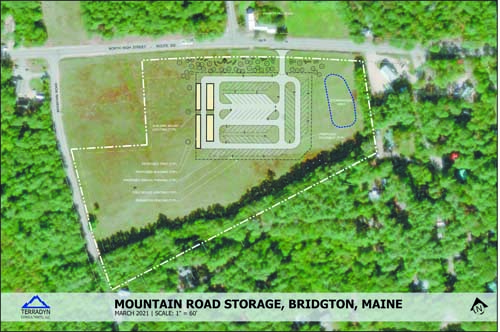Storage facility plan gains tentative approval

By Wayne E. Rivet
Staff Writer
After hearing a variety of questions and concerns, Jeff Amos admitted people generally fail to get excited about seeing storage facilities built.
But, Amos impressed upon Bridgton Planning Board members that developer Mark Lopez went to “great lengths” revising the Mountain Road Storage project to be a “good neighbor.”
One big change was the addition of more trees, bushes and shrubs along Route 302 to create a nature buffer.
Secondly, the taller posts (20 to 12 feet) and brighter lights were toned down.
“We’ve met the standards the best we can,” Amos told planners last week.
Lopez echoed that comment, “The project meets every standard of the Land Use Ordinance.”
After three-plus hours of public input and board deliberation, planners tentatively approved the project, 5-0 with conditions — 1. Use of an external illuminated sign; 2. The back end of the units will utilize corrugated metal, thus breaking up a “solid wall” look.
Planners will review Findings of Fact and Conclusions of Law at their next meeting.
Before last week’s discussion, Planning Board chairwoman Deb Brusini reminded viewers of the virtual meeting that the applicant bears the “burden of proof” in regards to whether the project meets town standards, and a decision is “not based” on the board’s opinion.
Representing applicant Mark Lopez, Amos, a professional engineer atTerradyn Consultants of New Gloucester, gave a brief overview of the project:
• It will be located at the Southeast corner of the Mountain Road property
• Four self-storage buildings, 11,600 square feet
• Additional 80 outdoor storage spaces, majority gravel, central portion paved, drain to oil/water separator in parking lot. The drain to stormwater pond is under DEP review
• Originally, the plan called for seven trees to be planted to line the front of the site, but after significant public comment, a greater number of trees, bushes and shrubs will be planted to create a significant buffer
• Lighting plan, before too many too bright, remove four light post around edge of property; light post dropped 20 to 12 feet tall; outdoor parking area motion sensor lights to be used, per public request
• No office, no need employee parking, water or sewer services
Brusini asked how a potential spill of gas or oil would be handled?
Amos said the applicant has in the lease agreement to limit use of oils, grease, gas at the site. Water runoff is directed to a catch basin, which has an oil/water separator (material floats to the top) that is inspected and maintained as necessary (outline by DEP guidelines).
Brusini then opened the session to public comment and questions:
Joe Coletti, of Alpine Road saw that the original application defined three parcels at this site, but the latest schematic only shows two — the storage facility area and a corner lot close to Mountain Road.
Amos said the applicant removed all components of a subdivision. He said the sole focus is on the storage facility, and there is no proposed subdivision at this time. Lopez chimed in later that other property could be developed in the future.
Stephanie Redding, an abutter on Alpine Road, appreciated lower light poles, as well as the use of motion sensors, but asked whether another buffer could be created at the southeast corner of the property since trees there “are thin”?
Lopez said the field has been mowed every year, but in the future, there is no plan to mow the area outside of the storage facility grounds, thus eventually trees and other vegetation will grow and create a thicker buffer.
Dave Moore, an abutter on Alpine Road, questioned how a storage facility fits with the rural character of that area?
Amos said the developer’s response to maintaining the area’s character is to go with “a significant landscaping buffer” consisting of multi-layers, several evergreen trees, flowering trees and bushes. He added that over time, some trees will reach 50-feet in height, and will block one’s view from Knights Hill Road toward Pleasant Mountain of a majority of the outdoor parking spaces.
“The idea is once mature, folks driving by will notice the tree corridor largely preserved,” he said.
Moore wondered how the lighting compares, say to a known example such as the Hannaford parking lot.
“What we are in for” 12-foot (light post) is hard to picture in my mind. What does it mean?” he asked.
Amos said the storage facility will be “far less lit than Hannaford,” and that taller poles use more intense light. Whereas, the storage facility lights “shine to ground and reduce ambient light,” he said. “The ambient light level will be zero in some areas. Most folks will be there in the daytime. It’s a safe level of lighting for users but not obtrusive to abutters. The nearest house is a couple of hundred feet away. It (the storage facility lighting) should not cast shadows. It’s no way as intense as a Hannaford parking lot.”
David Lyons of Mountain Road questioned whether the project meets the standard this it is “harmonious in regards to existing buildings and terrain?” He noted that the facade is blank white siding and green doors, no wood or stone.
When asked if the project met the intent of the Comprehensive Plan, Amos said, “The Comprehensive Plan is the will of the people of Bridgton; a document applied to create regulations and zoning ordinance; uses of each zone flow from the Comprehensive Plan document in the first place; this use being in compliance and allowed in this zone.”
Lyons disagreed that a storage facility is an appropriate use of that piece of property, and urged planners to enforce the standards.
Lopez countered that a storage facility is allowed in this district, “if it wasn’t allowed we wouldn’t be having this meeting,” he added.
“If it doesn’t preserve scenic beauty, it doesn’t mean permitted everywhere,” Lyons said.
Brusini stepped in to halt the “mini debate” over interpretation of the standard.
Planner Dan Harden asked Lopez if snowmobile access will continue there. Lopez noted that he has provided such access at several other of his properties, and will allow the snowmobile club “to do what they need to do.”
Lopez noted that high demand for outside parking is in the fall. “I turned away 50 people because I didn’t have space for them,” he said.
Because the board had a full agenda, Brusini wondered if the group might push deliberations to another night. Lopez, however, pushed for resolution that night. He noted he had been “generally accommodating” and that the process had started to drag on.
“We’ve gone through this far too long,” he said. “If the board doesn’t like it, deny the project and we’ll move on from there.”
Planner Greg Watkins favored moving ahead, and if need be, push other projects on the docket back.
Planner Dee Miller also favored continuing, “People should expect to be dealt with in a timely manner.”
Brusini said she was not comfortable tabling other applicants because it will make upcoming meetings cumbersome.
Planner Dan Harden felt the board should take projects in order that they arrive. “People should understand that they may be on agenda but might be pushed back,” he said.
Planners agreed to move forward with deliberation.
One issue was the back side of the units with planners looking for some type of change in design so it would not be a “blank wall.” Ultimately, the board and Lopez agreed upon a paneled/corrugated metal sections. Lopez will also look into whether a matte finish can be had, possibly use green vs white, and possibly use a “fake door” to break up the façade.


